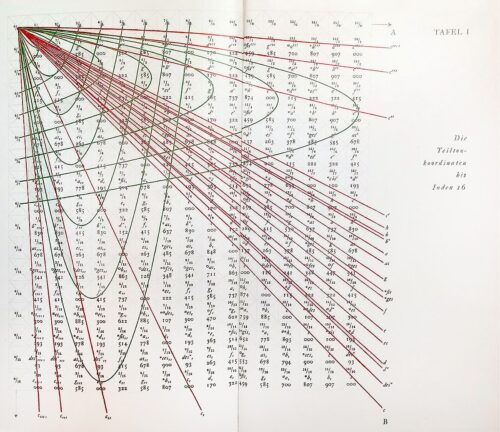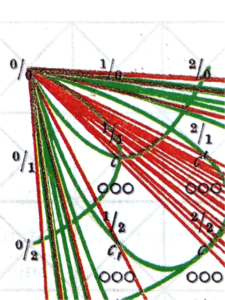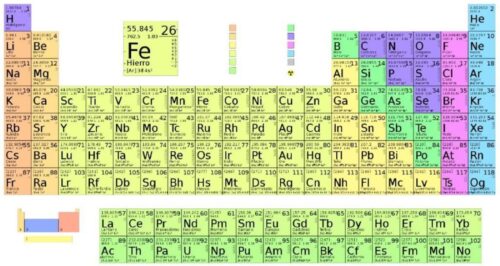In this article we present some ideas extracted and summarised from the book “Der hörende Mensch”* (1932) [The Hearing Man], by Hans Kayser.
As we all know, the Laws of the Universe, their norms and instructions, are basically inconceivable to human beings. Yet everything, everything that has a form — be it material or of higher dimensions — is constructed on the basis of these same universal Laws. Form is therefore the bridge that can be crossed to proceed towards that causal world of Principles that resonate and radiate in Space as Laws.
It is in the laws expressed in the «Science of musical Harmony» that we can best glimpse all this, and with the help of this science we can attempt to study the Laws of the universe; it could be said that in music they are more clearly reflected, we can “perceive” them better. The study of any musical instrument includes the study of the “Science of Harmony”, which is basically a “Science of proportions and correlations”.
For this reason, we will take this very topic as a starting point and also the piano keyboard as a simple Form for visualising musical notes and intervals. Later on we will see that this same model is also found in other sciences: Chemistry, Astronomy, Biology, Mineralogy, etc.
To orient ourselves, we need to establish a system of coordinates for musical notes. Let us define the term “coordinates”: these are the numerical values identified by the corresponding axes within a system of planar or spatial axes.
Here are the graphics drawn by the author of the aforementioned book. Musical notes (the diatonic scale) are inserted into this coordinate system, in the base-2 logarithmic scale.
A picture of a piano keyboard follows; the central C key is marked in red, indicated by the arrow.
Here is an enlarged image of the diagram of the initial part of the coordinate system, so you can see it better (to view details of the images, click on them).
In this graph, at the top left, the 0/0 point is the middle C (indicated by the arrow on the image of the piano keyboard); it is the “generating tone” from which all red lines start. The central C is the c-line, which is in the centre of the graph. Between the c line and the c’ line there are 14 red lines representing semitones within an octave; this is the diatonic scale. Then follow the lines c’’ – c’’’ – c’’’’, etc., ad infinitum, which are the C notes of successive octaves, to the right (on the piano keyboard) of middle C. Only one octave is represented in the detail diagram. The section to the right of middle C corresponds to the major scales and chords.
As a reflection, below the c line, to the left (on the piano keyboard) of middle C are the notes c, – c,, – c,,, – c,,,, of the lower octaves corresponding to the minor scales and chords.
Let us recall that in music, the major scale consists of seven notes. The distance between the successive notes of this scale is a whole tone, except for the 3rd and 4th, 7th and 1st degrees, which are separated by semitones. The minor scale also consists of seven notes, but this time the semitones are between the 2nd and 3rd, 5th and 7th degrees. The combination of the five whole notes and the two semitones is a phenomenon of Nature. In other words, the diatonic scale is a law of nature that is reflected in the sphere of sensation.
Let us now present two mathematical formulae — without going into detail — through which we arrive at the number I, that represents “Unity”. To differentiate it from the number 1, the Roman numeral I has been chosen.
1/∞ = I; ∞/1 = I; I = Unity = Infinity
In the way it is represented in these graphs, in tonal coordinates — or more precisely in the diatonic scale, I is not a major or minor Quantity, but the transition point of the tonal series. From the middle C (the c-line), the musical tones (the diatonic scale) go to infinity, and so do the numbers.
As we see in the diagram, the origin is 0/0; then there is 1/1, i.e. I. Within the tonal coordinates, Zero represents the imaginary real generating point of identical tones, i.e. tonal individualities, while I only maintains the balance of the harmonic group. Zero has the potential to become a reality, to achieve value; whereas I is already a reality that possesses value.
In truth, Unity is thus not a numerical quantity, but the first point from which the series of real numbers is differentiated. The number I is assigned a value concept, by means of which the infinite variation of numbers/values takes place (harmonic quantification). In Harmony, following the philosophical thought of Pythagoras, the “concept of number” is a holistic approach to knowledge.
The deeper meaning of music is that music is a number transformed into sound; number is a universal means of expressing a correlation.
Having mentioned the laws that govern “Harmony” in music, we can see that this same pattern or model is also found in other areas of science, which we will illustrate in a more concise form.
Chemistry
In atomic theory, positive and negative correspond to the dualism of major and minor scales.
The atomic weights in the Periodic Table of elements follow the pattern of musical notes. Each element has its own individuality.
As we know, the Periodic Table of elements is a table-like arrangement of the chemical elements, sorted by atomic number (number of protons), electronic configuration and chemical properties. This ordering shows periodic trends, with similar behaviour in the same column (with 7 or 8 elements per column). This is reminiscent of the “octaves” in music. Within these “octaves”, some features are congruent or correspond to other properties in the same regions of the other upper and lower octaves, and that’s why they’re placed on the same column.
Let us see some examples of correspondence with the musical scale, shown in the image above:
Tone value 1/1 corresponds to H (Hydrogen, atomic weight 1.0008), as would tone values 2/2, 3/3, 4/4, etc. That is, the H-axis would be the middle C.
The second element, Helium (He) has tone value 4: 4/1, 8/2, 12/3, 16/4, etc.; all with the same tone value.
The third element, Lithium (Li), with atomic weight 6.94 (= 7), value 7: 7/1, 14/2, 21/3, 28/4, etc.
In electrolysis, the anode (positive electrode) supplies O (oxygen), the cathode (negative electrode) supplies H (hydrogen), in a harmonic octave ratio: 2 H and 1 O = H2O. The fact that water is the result of this maximum balance of polarity, obtained through the simplest of all harmonic ratios between two elements, i.e. in a 1:2 octave ratio, should not be surprising considering the universal importance of water.
Astronomy
«If you want to listen to music, you may lack the baton, or even the conductor, but certainly not the musicians and instruments, let alone the score — the work: the cosmos — which is made to resonate and be played and intoned.»
Johannes Kepler believed in a God, in a divine Geometry, in a powerful Music of the spheres and of the entire cosmos. And there are numbers here, numbers that sound perfect! If we want to find harmonies, we must not look for them in the distances between celestial bodies, but in the motions themselves.
In any case, with respect to the distances between the planets, there is a harmonic morphology; the correspondences between these distances and the coordinates of the tones of music develop as follows:
— The distances of the planets are in the base-10 logarithmic scale.
— The coordinates of the musical tones are in the base-2 logarithmic scale.
The motions of the celestial bodies of the Solar System are nothing more than a continuous “playing” together, of a spiritual and non-sensory nature. These rhythmic motions form chords that are always seeking perfect harmonic combinations. The melody of the planets, their fundamental tones, all form a “chord to create” and re-create the divine Geometry: “God geometrizes”.
We will only briefly mention some of the correspondences between the Solar System and the laws of musical notes (the diatonic scale) that fit into this system of tone coordinates (see diagram), because going into detail is beyond the intent and purpose of this article.
Below are just a few of these correspondences (according to Johannes Kepler).
Always starting from the middle C:
- Mercury — C, third octave
- Venus — A, second octave
- Earth — G, second octave
- Asteroids — D♭ diminished, second octave
- Jupiter — B♭, first octave
- Saturn — G, first octave
- Uranus — E, first octave
- Neptune — D♭, first octave
The inner planets (Mercury, Venus, Earth, Mars) have a major scale character, with intervals of second, third, fourth; that is, in terms of position points, these planets form a solid and harmoniously organised unit. While the outer planets (Jupiter, Saturn, Uranus, Neptune) form a diminished seventh chord.
According to the author of the aforementioned book, there was a planet in place of the asteroids, which we call “Planet X here. Due to its intermediate position and its D♭diminished note, it was in a very unstable position, which caused its total destruction.
We must point out that Jupiter also has a flat (!!) note, a B♭. Why did it not suffer the same fate as this Planet X?
Between Earth and Saturn there is a distance of an octave, both with the note G.
As we know, every celestial body has a fundamental tone. From this fact we deduce that the four major asteroids were once part of a single planet, because Ceres and Vesta have a C#; Pallas and Juno also have a C#, only an octave higher.
*
«All forms and dimensional correlations are the expression of the invisible relationships of the power of spirit.» (Unser Denken ist in Sonderfall der Gestaltung überhaupt, Immanuel Kant)
Every harmonic thought is a proportional thought.
It is a bridge between the World of Ideas and that of Forms, serving the universal order of Numbers: “The manifested evolution is created… in a limitless striving of harmony”.
Beethoven, Symphony No. 9: «O Freunde, nicht diese Töne, sondern lasst uns angenehmere anstimmen und freudvollere!» [«O friends, not these sounds, but let us sing more pleasant and joyful ones!»]
________________________________________________________________________
* The original book is in German; it has not yet been translated into any other language.
Note: This article is published on the occasion of the conjunction of Venus (5th Ray, concrete Science) with Uranus (7th Ray, ceremonial Order).
We recommend reading the following documents dealing with related topics.
Documents in English: The Creating Sound, The Solar Orchestra
Documents in Spanish only (translated from the unpublished original in Italian): Del Número, Real e Irreal, Los Números y las Mónadas.
In addition, there are other similar texts in the Documents section.
Other articles published on related topics: The solar Scores, Twenty-six centuries of Space.










Imagine one “tuning fork” which contains all of the complete infinity of sound and light in one Model which allows understanding resonance to every part or note…such is the Great Singularity, as shown in the CGF paradigm.